Podcast
Questions and Answers
What is the study of language history and change known as?
What is the study of language history and change known as?
- Linguistic Evolution
- Historical Syntax
- Etymological Analysis
- Philology (correct)
Who was shocked to discover a regular pattern of similarities between ancient Sanskrit words and ancient words in classical Western languages?
Who was shocked to discover a regular pattern of similarities between ancient Sanskrit words and ancient words in classical Western languages?
- William Jones (correct)
- Thomas Brown
- John Smith
- James Cook
What did William Jones observe similarities between in different languages?
What did William Jones observe similarities between in different languages?
- Modern French and ancient Latin
- Ancient Sanskrit and ancient words in classical Western languages (correct)
- Medieval English and ancient Greek
- Classical Chinese and ancient Egyptian
What did William Jones' discovery in 1780 lead to?
What did William Jones' discovery in 1780 lead to?
What was the focus of historical linguistics?
What was the focus of historical linguistics?
What is the focus of the study of historical linguistics?
What is the focus of the study of historical linguistics?
What does philology study in relation to language history and change?
What does philology study in relation to language history and change?
What did William Jones, a British judge stationed in India in 1780, discover?
What did William Jones, a British judge stationed in India in 1780, discover?
What is the significance of the discovery made by William Jones in 1780?
What is the significance of the discovery made by William Jones in 1780?
What did William Jones observe similarities between in different languages?
What did William Jones observe similarities between in different languages?
Define the study of historical linguistics and its main focus points.
Define the study of historical linguistics and its main focus points.
Explain the significance of William Jones' discovery in 1780 regarding the similarities between ancient Sanskrit words and ancient words in classical Western languages.
Explain the significance of William Jones' discovery in 1780 regarding the similarities between ancient Sanskrit words and ancient words in classical Western languages.
What is the main focus of philology in relation to language history and change? Provide an overview of its scope.
What is the main focus of philology in relation to language history and change? Provide an overview of its scope.
Briefly discuss the variety of languages spoken in different parts of the world and their connection through family trees.
Briefly discuss the variety of languages spoken in different parts of the world and their connection through family trees.
Explain the role of historical linguistics in understanding the development of modern languages from older languages.
Explain the role of historical linguistics in understanding the development of modern languages from older languages.
Flashcards are hidden until you start studying
Study Notes
Historical Linguistics and Language Change
- The study of language history and change is known as historical linguistics.
William Jones' Discovery
- In 1780, William Jones, a British judge stationed in India, discovered a regular pattern of similarities between ancient Sanskrit words and ancient words in classical Western languages.
Similarities Observed by William Jones
- William Jones observed similarities between Latin, Greek, and Sanskrit in terms of grammar and vocabulary.
Significance of William Jones' Discovery
- Jones' discovery led to the establishment of historical linguistics as a field of study.
- His discovery showed that many languages descended from a common ancestor, challenging the prevailing view of language origins.
Focus of Historical Linguistics
- Historical linguistics focuses on the study of language change and development over time.
- It seeks to understand how languages evolve, diverge, and converge.
- Historical linguistics explores language relationships, language families, and language trees.
Philology and Language History
- Philology studies language history and change, examining written texts to understand language development and evolution.
- Philology focuses on the language as a system, exploring its structure, variation, and change over time.
Scope of Historical Linguistics
- Historical linguistics encompasses a broad scope, examining language relationships across the world.
- It explores language families, such as the Indo-European language family, and their connections.
Understanding Language Development
- Historical linguistics plays a crucial role in understanding the development of modern languages from older languages.
- It helps to identify language relationships, language contact, and language diffusion.
Language Diversity and Family Trees
- The world's languages exhibit remarkable diversity, with over 7,000 languages spoken globally.
- Historical linguistics uses family trees to illustrate language relationships, highlighting connections between languages and their common ancestors.
Studying That Suits You
Use AI to generate personalized quizzes and flashcards to suit your learning preferences.




